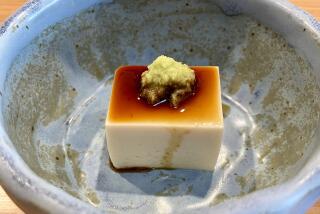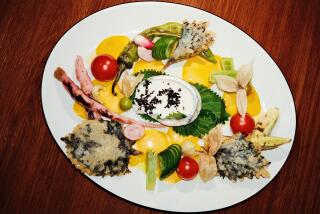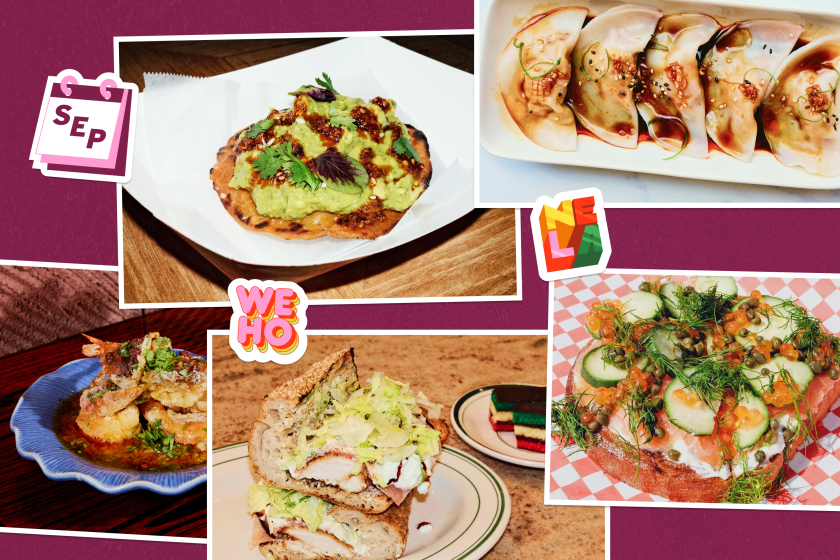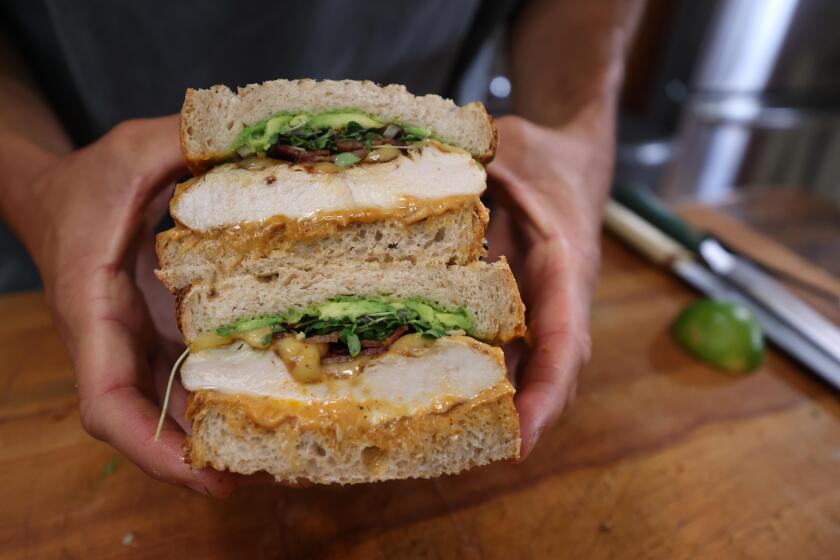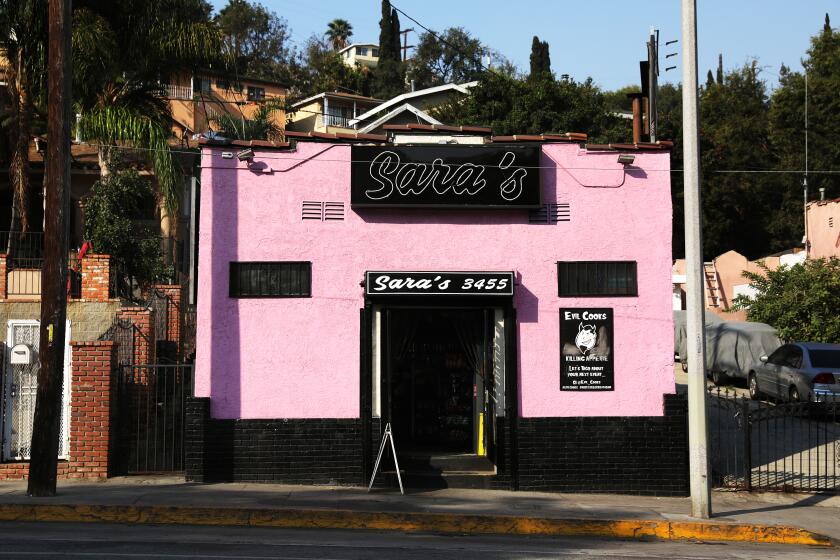Taking raw beyond copycat cuisine
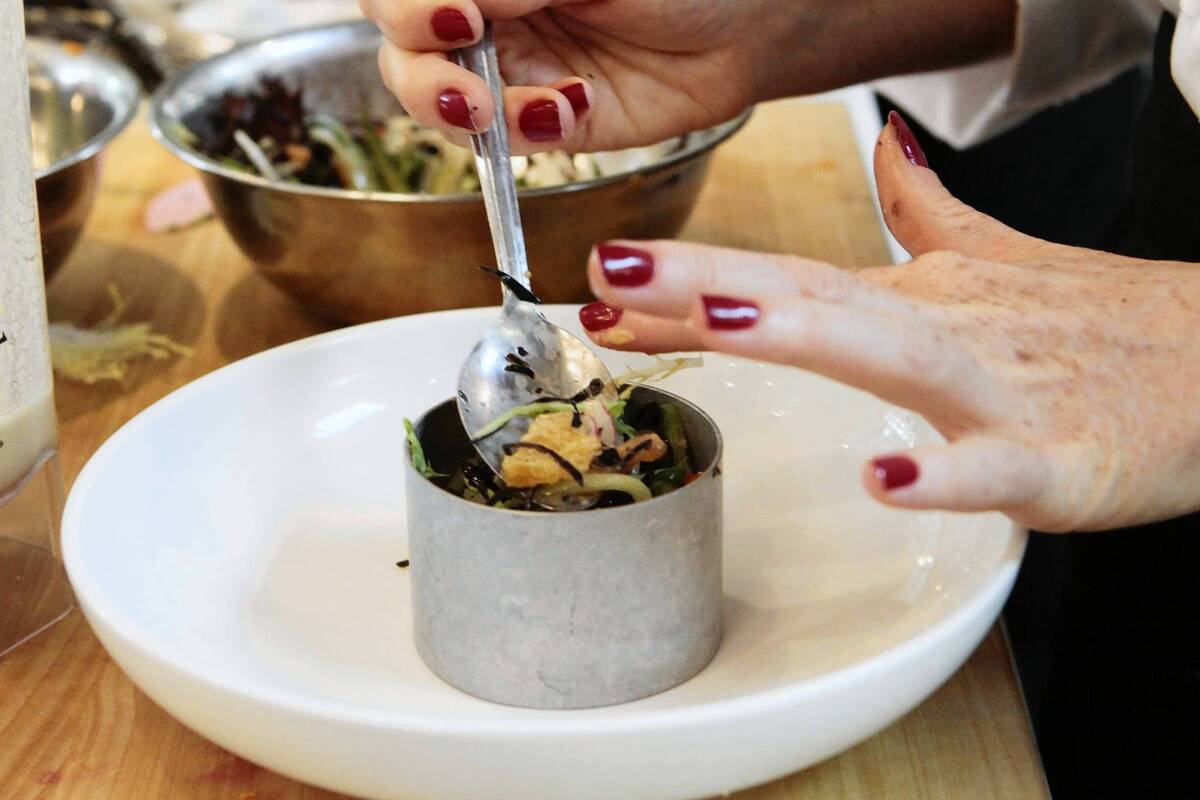
The kimchi dumplings at Matthew Kenney’s M.A.K.E. restaurant in Santa Monica might be the poster dish for modern raw cuisine: origami-like bundles of cashews, pickled cabbage and tahini, packaged in wrappers made with dehydrated coconut purée mixed with cilantro juice so that they’re bright green, and served with sesame-ginger foam, nasturtium flowers and micro-cilantro. Hello to the new raw food.
The dumplings, one of the most popular items on the menu at the 3-month-old restaurant, reflect a culinary leap from that ‘80s raw food stalwart, zucchini “noodle” lasagna (though that’s on the menu too — what one restaurant critic called the best version of this dish she’s ever had). In stride with Mayor Antonio Villaraigosa adopting Meatless Monday and the hip factor at vegan restaurants and juice bars such as Cafe Gratitude, raw food’s no longer a fringe cuisine.
“It’s not about copycat food,” insists Kenney, a James Beard-nominated chef who once slung butter and bacon and — after a life-changing “aha moment” several years ago — now has vegan raw food restaurants in Oklahoma City and Chicago as well as Santa Monica, with another opening in the fall in Miami. “The kimchi dumplings aren’t trying to be pork dumplings. A kelp noodle is a kelp noodle, not pretending to be pasta alfredo. Defining raw food as its own cuisine is the goal.”
To further the mission, Kenney, a willowy 48-year-old who looks a decade younger, is expanding the Matthew Kenney Academy, a culinary school he started in Oklahoma City in 2009 based on rigorous classic techniques applied to raw food. Weekend courses at the Santa Monica academy, which began in November, have been sold out (despite the $575 price tag) and include classes such as Essentials of Raw Cuisine, Modern Raw Techniques and Weekend Detox — devoted to the art of preparing juices and “liquid meals.” The online academy launched on Jan. 7.
The culinary academy attached to the Santa Monica restaurant looks like a cross between a high-end health food store and cutting-edge professional kitchen: El Bulli meets Erewhon. Stocked on the kitchen shelves are bins of walnuts, almonds and cashews, wheat groats, dried sea vegetables, hemp seeds, bottles of coconut aminos (a soy-free seasoning sauce) and all manner of powdered super-foods, including golden berry, açaí, goji and maca.
The abundance of ingredients at the disposal of rawist chefs has burgeoned in the last several years, notes Kenney. “Even raw cacao was not available in 2003,” he says.
On one wall is a bank of dehydrators, all set to various times and temperatures (nothing gets heated to more than 115 degrees to preserve what some rawists claim to be beneficial enzymes). They’re filled with trays of tomatoes, za’tar crackers and tree nut cheeses.
But raw doesn’t mean just dehydrated anymore. Other flashy equipment includes Japanese turning slicers, smoking guns, masticating juice extractors, Pacojets, immersion circulators and an Anti-Griddle, a machine that quickly freezes sauces and purées instead of heating them.
“Early pioneers of raw food weren’t necessarily chefs trained in culinary arts; technique was more random,” Kenney says. “Some results were good, but there wasn’t a lot of consistency or refinement to the food.
What’s changed is what we focus on — ingredients but also technique and culinary skills.”
And so on a recent Saturday in December, instructor Michael Vincent is imparting some raw food culinary skills to a group of students, each armed with a cleaver and standing over a coconut. (“Coconut 101” is part of the basic raw cuisine weekend course.) The meat of the coconut is removed, soaked and puréed with beet, carrot, spinach or cilantro juice, until just the right consistency. Then it’s spread carefully and evenly on a dehydrator tray and dried for eight to 10 hours until it’s pliable enough to make dumpling wrappers.
“Wow,” says one student, folding a square of green coconut wrapper around her cashew-vegetable filling, “nobody said this was going to be easy.”
M.A.K.E., 395 Santa Monica Place, Suite 333, Santa Monica, (310) 394-7046, https://www.matthewkenneycuisine.com.
More to Read
Eat your way across L.A.
Get our weekly Tasting Notes newsletter for reviews, news and more.
You may occasionally receive promotional content from the Los Angeles Times.
